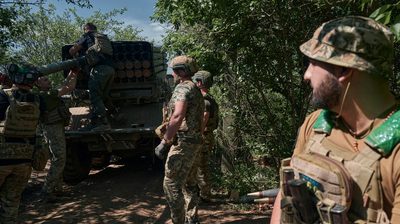
Ukrainian forces penetrated an initial line of Russian defenses on the war’s southeastern front this week, raising hopes of a major breakthrough in its counteroffensive campaign as troops push toward the Sea of Azov to cut off Russian supply lines.
Ukraine still has a long way to go — but the first line of defense is widely seen as the toughest, and the going could get easier from this point on.
Military analysts say the more rapid progress made in the last two weeks is also a good sign, slightly raising their hopes of a decisive victory two months into the counteroffensive.
“The chances of it happening are growing,” John Herbst, senior director of the Atlantic Council's Eurasia Center, said of a major breakthrough. “If [we] are right about the second defensive line the farther east you go, then what we're seeing today means a bigger chance of a big breakthrough.”
Though he is more optimistic now, Herbst does not expect an immediate breakthrough, foreseeing only modest gains unless the West ramps up the delivery of more weapons.
“I don't rule out a larger success, even if our weapons supplies remain what they are,“ he said, ”but we cannot count on it.”
Kyiv has publicly expressed annoyance with the criticism around its counteroffensive, with veiled references to news reports citing anonymous U.S. officials. But Ukrainian officials admit the campaign that launched in June has been relatively slow-going compared to fast operations last year that took Moscow completely by surprise.
Still, Ukraine has taken back dozens of more square miles of territory than Russia did in its offensive this year. Moscow only captured the city of Bakhmut over the spring in a costly campaign.
Ukrainian Minister of Foreign Affairs Dmytro Kuleba further pushed back against criticism on Friday, telling CNN that Ukraine is “not failing.”
“We are moving forward,” Kuleba said. “We’ve liberated dozens of square miles of land through minefields with no air coverage.”
Ukraine last week captured the town of Robotyne in the southeastern Zaporizhzhia region, entrenching itself much deeper into Russian-occupied territory. Russian sources claim it is holding onto some territory in the southern outskirts of the city.
Kyiv is now attacking on either side of Robotyne, toward the towns of Verbove and Novoprokopivka. If successful, that could give them a leg up in another advance toward the regional hub of Tokmak.
Taking back Tokmak would enable Ukraine’s forces to advance toward Melitopol near the Sea of Azov and achieve a major success in the counteroffensive operation. However, capturing Tokmak is far from certain, as satellite images show extensive defenses bulwarked around the town.
Andriy Kovaliov, a spokesman for the General Staff of the Armed Forces of Ukraine, said on television Friday that Ukraine is moving toward Novoprokopivka and putting pressure on Russian defenses.
Russian military bloggers are reporting advances toward both Verbove and Novopokrovka but stress that Ukraine is largely failing in its efforts to further pierce Russian lines.
Even without a major victory in Tokmak, the deeper Ukraine gets into Russian-held territory, the more danger it poses to crucial supply lines running east to west, from Russia’s mainland to Crimea. Ukrainian troops are moving into artillery range of those supply lines, a major threat to Moscow.
Analysts say Ukraine breaking through the first line of the dreaded “Surovikin” line of defense is significant in and of itself.
The defenses are named for the Russian Gen. Sergei Surovikin, who ordered three layers of trenches, minefields and anti-tank obstacles patterned like dragon’s teeth ahead of the counteroffensive.
“Usually when you get through the first line, every next line is easier,” said Tomasz Blusiewicz, a research fellow at the Hoover Institution. “But the question is … do they have enough manpower and do they have enough material to fill in that breach with defenses to make sure the Russians don't counterattack?”
Blusiewicz said Ukraine's progress is impressing him, but he does not expect a major breakthrough anytime soon. However, he said Ukraine can keep the pressure on Russian forces, make them increasingly remain on the defensive, and break morale.
“They largely have this army that doesn't really want to fight,” he said of Russia. “An army with low morale, you can still kind of wage a defensive war, but it's so much harder to counterattack.”
Another plus for Ukraine is that it likely has several more months for the operation, so long as western support keeps pace — which will depend on Congress passing a $13 billion funding request from the Pentagon.
As winter approaches, analysts say the colder weather does not necessarily mean Ukraine has to grind operations to a halt.
Jan Kallberg, a non-resident senior fellow with the Transatlantic Defense and Security program at the Center for European Policy Analysis, said by the winter, Ukraine may be able to hinder supply lines with artillery and create a catastrophe for Russia in Crimea.
“The supply line for the land bridge and the Kerch [Strait] bridge also have to feed the Crimean population, where the Russians want to maintain some sort of normality,” he said. “If their logistics chain starts to crumble … you will see a massive exodus.”
Kallberg explained that could turn Crimea into a “competition between military needs and civilian” resources.
“And Russia doesn't want that, because it's very much saying that they're losing,” he said. “That’s going to be a really tricky equation for the Russian leadership.”